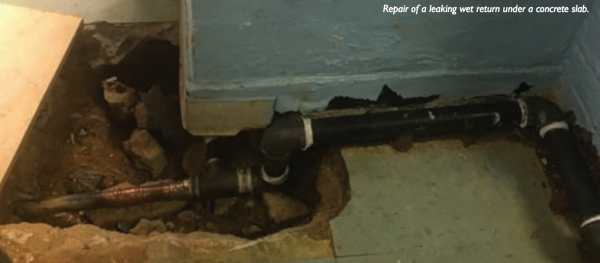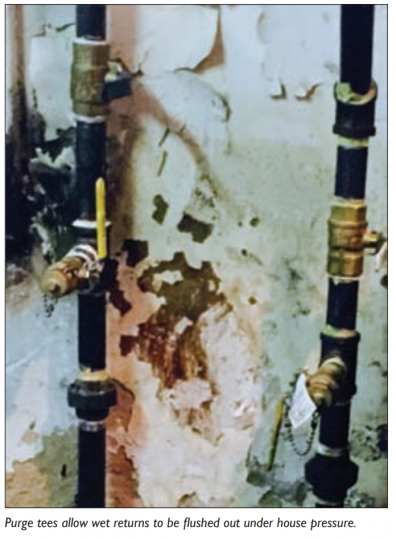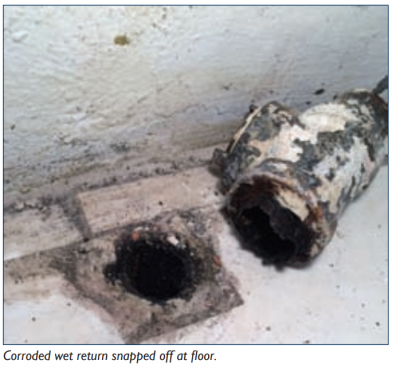This all-technical, three-hour seminar will make you familiar with the many types of old steam heating systems and what goes wrong with them. Dan Holohan’s easy-to-follow...
Wet Returns
Whenever I quote a replacement steam boiler on a system with wet returns, I always quote a price to replace the wet returns, or at a minimum flush them out. Why? Most steam systems, at this point, are past the century mark, or rapidly approaching it. Dry returns typically do not present a problem. But, wet returns are the source of many problems when replacing a steam boiler.
Wet returns, by definition, are below the water line and are continuously full of water. In many cases, they are buried below concrete slab floors. They are the low point in the system and accumulate sediment, scale and rust. As they are open to the atmosphere, they are often corroded and leaking. After many decades of rust and corrosion, in most cases, there is not much good metal left. Even if the pipe is sound, I guarantee they are full of mud.
Even if they are not leaking, they can still cause problems. Many times, an old commercial boiler that may have held 80 to 100 gallons of water is replaced with a newer ,higher efficiency boiler with a similar BTU input that may hold less than a quarter of that amount of water. With the old boiler, the larger water content allowed the burner to fire for long cycles as the condensate filters back to the boiler through returns clogged with decades of sediment and mud.
With a new lower water content boiler, the burner shuts off on low water after just a few minutes of firing, as the condensate backs up into the returns. The new boiler does not have the 100 gallons of “cushion” to work with. Now, you start grasping. You think a boiler feed pump will solve the problem. It won’t. It just delays the inevitable burner short cycling.
If you have an automatic water feeder, it will fill the boiler with fresh water in an attempt to maintain the water line. In addition to scaling and corrosion issues due to the introduction of large quantities fresh water, you will also have to deal with flooded boiler callbacks when the returning condensate finally filters through the muck and returns back to the boiler.
Save yourself the headaches and include replacing the wet returns in your original quote. Avoid having to return back to your replacement jobs and explain to your client why it was not done in the first place. You are also more likely to get paid for the additional work.
If only I would follow my own advice. This fall, we replaced a commercial steam boiler in a church in the Cleveland Park neighborhood of Washington, D.C. This work was done in late October, just as the weather started turning cold. We installed an eight-section boiler with a power gas burner. There were two dry returns and one wet return in the system. The wet return ran under a concrete slab. The nursery and child care facility for the church were in the basement. It would have been very disruptive to replace this wet return. I decided to tie this back in to the new boiler and hope for the best. Hope is rarely a good strategy when it comes to buried wet returns.
I received a call from the church in February. Water was bubbling up through the concrete floor. I did not need to go to the job site to know what it was. I sent my lead service tech there to identify the cause. Sure enough, the wet return was leaking. It is no fun busting up concrete to find the leak, cut out the bad pipe, and re-fit with new pipe (See photo).

In this case, we used a combination of Pro-Press and threaded black steel pipe to make the repair (See photo). The work is noisy, disruptive and laborious. Busting up concrete with a rotary hammer is never any fun. Looking back, I should have recommended this work be done with the boiler change-out. It is easy to be the general after the battle is over. Lesson learned. Again.

Sometimes the pipe is sound but full of crud and sediment. If that is the case, we will cut in a flush port (See photo). This allows us to isolate the wet return from the dry return, hook up a water hose, and flush it out under house pressure. Be careful, because if the pipe is not sound it could fail under house pressure, and you will definitely be replacing the piping. If the pipe is sound, when you flush it out, you will be amazed at the amount of crap that comes out the other end. You will wonder how the condensate ever made it back to the boiler.

We use this solution sparingly, as it is always better to replace the wet return rather than flush it out. Again, we learned this lesson the hard way on a recent project. We were installing a Peerless commercial atmospheric draft steam boiler on a 1920s vintage two-pipe Dunham Vapor System. The dry return dipped into the slab for about three feet to traverse a hallway and drop into the boiler room.
In this case, I made the decision to cut in a flush tee and flush out the three feet of buried pipe. What are the chances that the only buried pipe in the entire system, and only three feet of it, was bad? The answer: 100 percent.
When my installation technician put a Sawzall to the pipe to cut in a tee, the return pipe snapped off at the floor. The only thing holding the pipe together was rust and paint. Now, we get to bust up tile and concrete. This client was not as understanding as the previous job, and we are doing the repair for free. Some lessons are learned the hard way.
When you run across wet returns, it is best to go ahead and figure on replacement right from the start. Learn from my mistakes. You will have a happy client and a fatter wallet.
Dan Foley is president and owner of Foley Mechanical, Inc. based in Lorton, Virginia. (www.foleymechanical.com). FMI specializes in radiant, hydronic and steam systems as well as mechanical systems for large custom homes.
Leave a comment
Related Posts
We always have turkey for Thanksgiving. I mean who doesn’t? My job wasn’t to cook it, though; it was to eat it.
I had written a story for Plumbing & Mechanical a while back about a fella in Canada who sent me this email: "Our problem is that five out of hundreds of univentilator co...